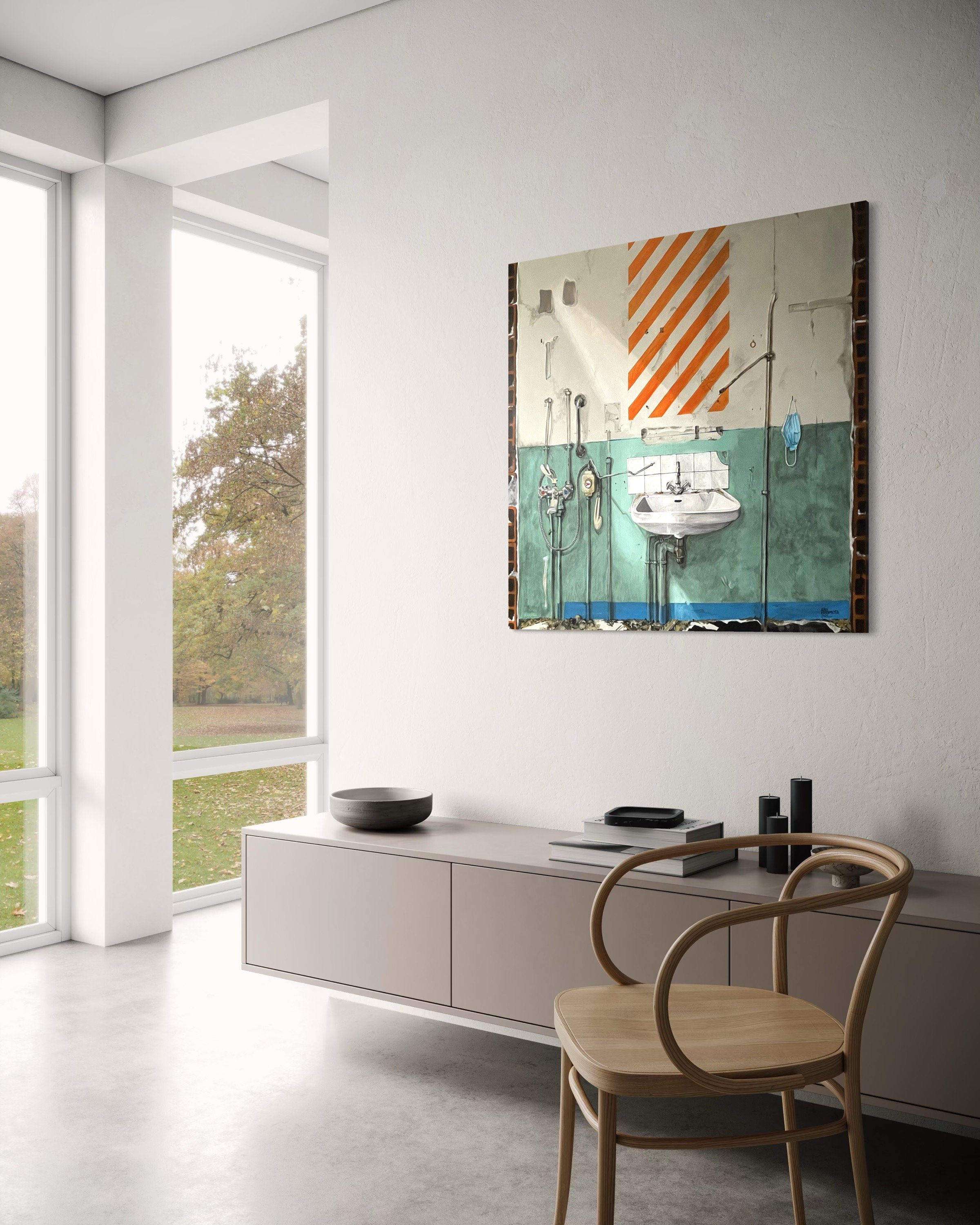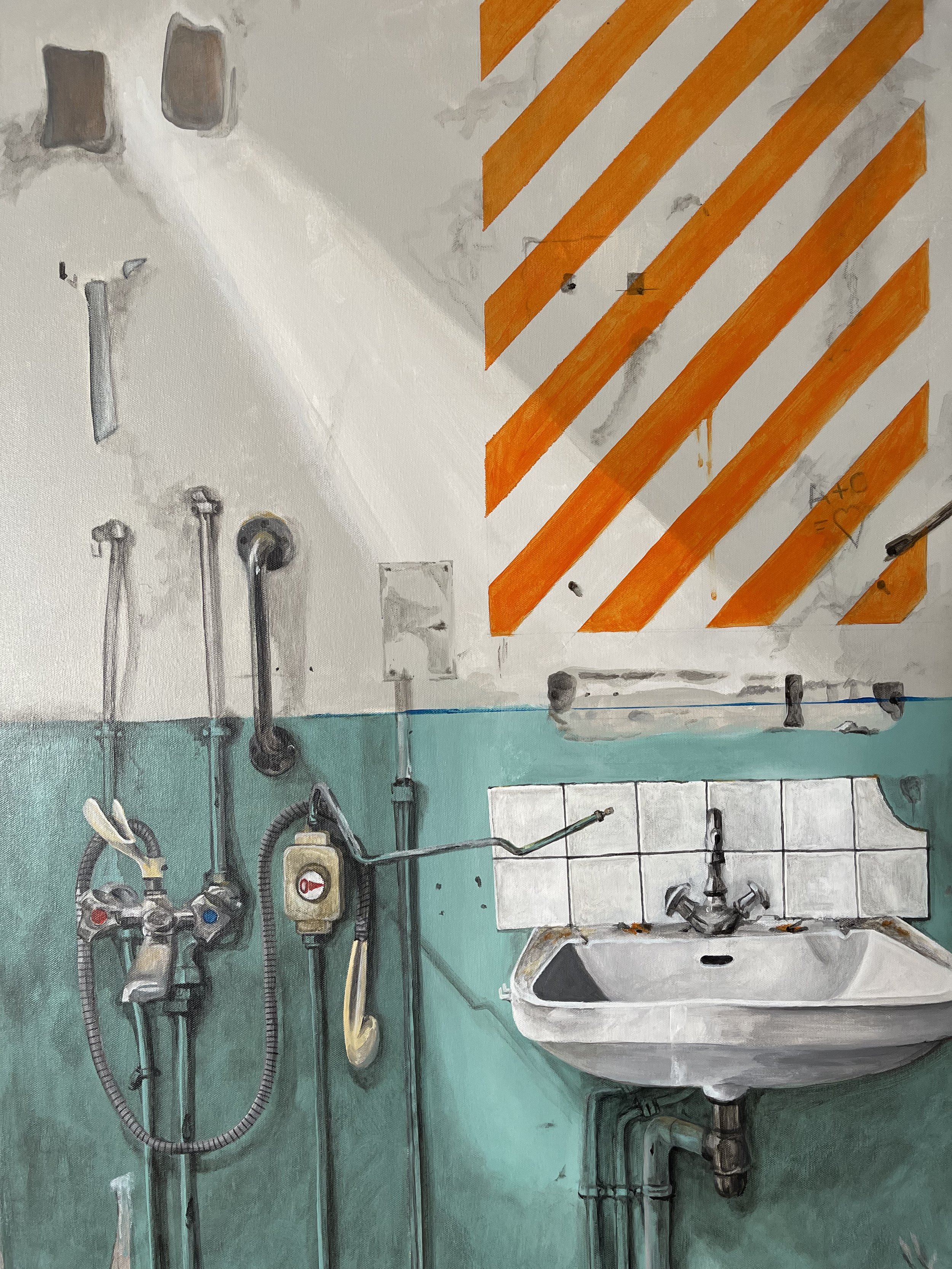When Walls Remember — A Figurative Reading of Décrochages
The Memory of Walls
Some places keep speaking long after we have left them.
Their walls retain the trace of gestures, of absences, of suspended breaths.
In Décrochages, I invite the viewer to listen to that silence —
the silence of a world frozen between care and abandonment.
Contemporary figurative painting here reveals a rare power:
that of giving voice to the inanimate.
A sink, a few pipes, orange stripes, a forgotten mask —
so many signs of a time when hygiene became both a symbol of anxiety and of redemption.
True to my visual language, I blend architectural precision with pictorial emotion.
Each line breathes with tension — between order and chaos, measure and fragility.
Beneath the surface, one question remains:
What endures of our gestures, when the walls remember them better than we do?
The Architecture of Silence
The first glance pauses on the construction.
Everything is framed, structured — almost surgical.
The wall’s median line, the sink, the orange diagonals:
a geometry that borders on the cold perfection of engineering plans.
But as a figurative painter of the sensitive, I seek to turn that precision toward emotion.
The light is not realistic — it is breathed.
It slides across the tiles, passes through the surfaces, slips into the absences.
I painted the structure as one paints skin: with modesty and memory.
The viewer is drawn into a space where matter itself becomes language.
Here, architecture is no longer a backdrop —
it is a metaphor for the human.
Every pipe, every crack becomes an organ;
every void, a breath.
Figurative Art as an Act of Memory
My contemporary figurative painting is part of a quest for visual memory.
My works are fragments of reality recomposed — places transposed into a singular pictorial syntax.
Décrochages continues this approach: to depict, not to imitate, but to bear witness.
The suspended mask, almost anecdotal, becomes a symbol — that of time standing still.
The canvas questions the fragility of the present, the invisible weight of repeated gestures.
I do not paint nostalgia — I paint persistence.
My figurative art does not seek pure beauty, but emotional accuracy.
At a time when much of French contemporary art explores abstraction or pure conceptual forms,
Décrochages chooses the courage of the visible.
It reminds us that realism can still move us — if it opens itself to the poetry of lived experience.
From the Care Room to a Space for Reflection
This work also resonates within the professional world.
More and more companies, in France and across Europe, are choosing to integrate figurative art into their spaces —
not to decorate, but to signify.
Placed in a lobby, a meeting room, or a quiet area, Décrochages acts as a symbolic mirror:
it speaks of resilience, collective memory, and the beauty of traces left by human work.
Art in the workplace is no longer a luxury; it has become a lever of culture and meaning.
Within the framework of an art-leasing or corporate patronage program, this work resonates deeply —
it dialogues with notions of care, attention, and transmission —
key values of today’s professional world.
My work seeks to offer an aesthetic of the real — one that soothes and questions at the same time.
Painting the Trace, Breathing Time
“I paint what remains of silence after movement.”
This phrase condenses the philosophy of Décrochages.
Everything here is a mingling of presence and absence.
Walls become flesh, pipes become skeletons, light becomes breath.
Painting does not merely represent — it revives.
And what seemed lifeless — a technical space, a functional remnant — reveals itself as a bearer of emotion.
I tried to capture the moment when matter remembers,
when the pictorial gesture becomes a ritual of memory.
It is a work meant to be seen slowly, listened to deeply, and breathed differently.
The Murmur of the Wall
Beneath the layers of paint, there is a voice —
discreet, patient, almost human.
It whispers: “Remember what you were when you still touched the world.”
Décrochages is not a painting about the pandemic, nor about decay.
It is a meditation on the trace —
on what endures when everything seems to have vanished.
The orange stripes, like a signal, recall that danger was also a form of awakening.
And within this square frame of 100 × 100 cm,
the viewer finds a fragile balance —
between the fear of emptiness and the beauty of what comes after.
FAQ — Figurative Painting and the Memory of Place
-
The artwork is executed in acrylic on varnished canvas, 100 × 100 cm.
Rouschmeyer works in successive layers, alternating between glazes and dry touches,
to create that silent density which has become a hallmark of his contemporary figurative painting. -
Because the artist does not seek to reproduce reality, but to reinterpret it.
Here, the figurative becomes an emotional language, not a documentary one. -
A work like Décrochages finds its full place in the contemporary corporate world —
not as a mere decorative element, but as a space for reflection and breathing.In a reception area, a meeting room, or a passageway, it establishes a silent presence that invites one to slow down, to observe, to feel.
The canvas acts as a symbolic mirror — it evokes trace, memory, and resilience, values deeply shared with the world of work and collective creation.When figurative art enters a professional setting, it reminds us that every organization is built upon gestures, rhythms, and human presences.
It is no longer about adorning walls, but about re-enchanting the everyday, reintroducing meaning, emotion, and a sense of interiority into functional spaces.To integrate Décrochages within a company is to affirm that culture is not a luxury or an afterthought —
it is a living force, a lever of balance and identity. -
Oui. Le prix atelier est de 5 300 €, incluant certificat, facture et transport assuré (France / Suisse / UE).
-
Yes, upon request. The artist offers a refined oak tray frame in a light natural finish.
What the Walls Say
Décrochages is more than a figurative painting —
it is a fragment of time, a pictorial breath between shadow and light.
It unfolds an entire sensitivity within my artistic practice —
the one that links the human gesture to architecture, memory to matter.
In a world where everything fades so quickly,
this canvas reminds us that the trace, at least, remains.
And that by listening to the wall,
one can still hear presence beating within it.






